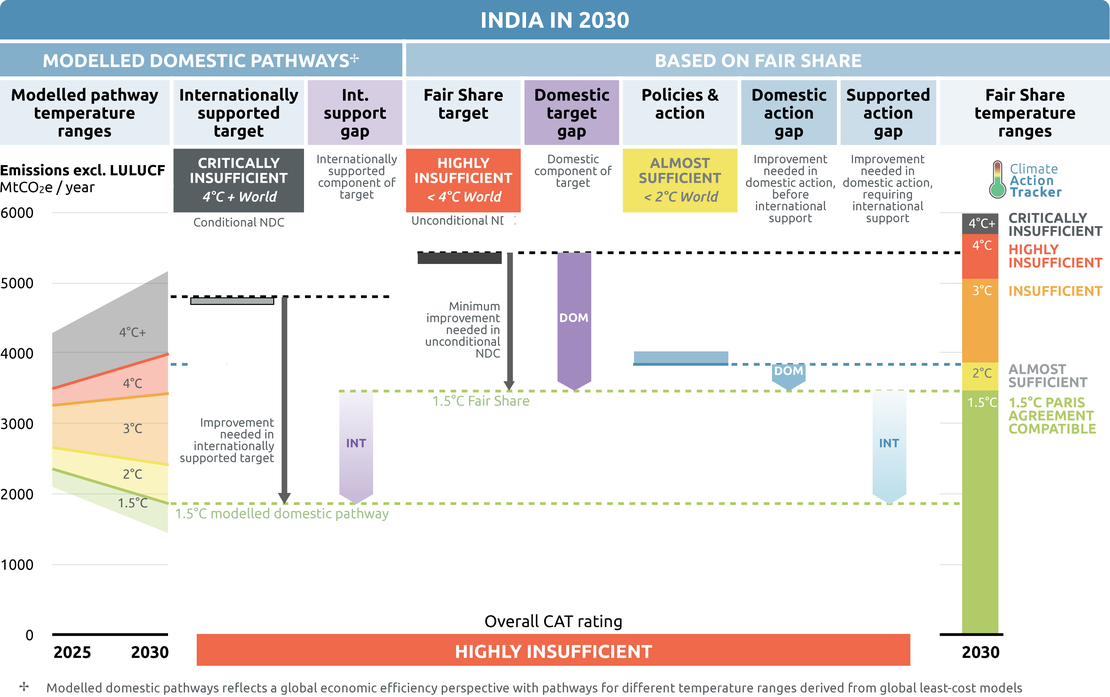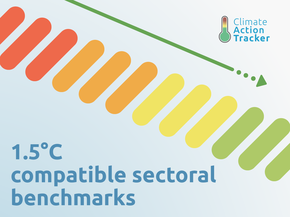Targets
Paris Agreement targets
India submitted an updated NDC on 26 August 2022. We are currently analysing this new NDC and will update the India country assessment shortly.
NDC description
India’s first NDC has three main elements (Government of India, 2015):
- An economy-wide emissions intensity target of 33%–35% below 2005 levels;
- A electric power capacity target of 40% installed capacity from non-fossil-based energy resources by 2030, to be achieve with internationally support); and
- A carbon sink expansion target of creating an additional (cumulative) carbon sink of 2.5–3 GtCO2e through additional forest and tree cover by 2030.
We take India’s emissions intensity target as its unconditional contribution to meeting the Paris agreement and rate that against what a fair contribution would be. We take the 40% non-fossil capacity target as conditional on international support (‘internationally supported target’) and rate this against where India’s emissions need to be to be 1.5°C compatible, based on modelled domestic pathways. We rate the capacity target as “Critically insufficient" and the emissions intensity target as "Highly insufficient".
The CAT methodology for rating NDCs is based on GHG emissions from fossil fuels. We exclude the land sector from our calculations and thus do not evaluate the contribution of India’s carbon sink expansion efforts.
We rate India’s 40% non-fossil installed capacity target as "Critically insufficient". The “Critically insufficient” rating indicates that India’s internationally supported target in 2030 reflects minimal to no action and is not at all consistent with the Paris Agreement’s 1.5°C temperature limit. If all countries were to follow India’s approach, warming would exceed 4°C. The rating is based on what global least cost modelled domestic pathways say India needs to be doing within its borders, with international support, to achieve the Paris Agreement’s 1.5°C limit.
As of July 2021, India had 39% non-fossil installed capacity based on data available from its Central Electricity Authority (CEA, 2021b). In other words, India is poised to achieve its capacity target a decade early. Under policies and action, India is on track to achieve around 60-65% of non-fossil installed capacity by 2030. If India were to achieve the top of that range - 65% non-fossil installed capacity in 2030 - instead, our rating would improve, but only by one category to ‘Highly insufficient’. Even if India is not responsible for paying for all reductions, it should plan on how fast it could reduce its emissions if there were sufficient international support available, and not to lock into a high carbon future. This would mean to begin phasing out coal use and adopt emission reduction plans across the economy, and to clearly specify what international support it requires to achieve this goal.
We estimate that India’s emissions intensity target would result in an emissions level of between 5.3-5.4 GtCO2e (excluding LULUCF) in 2030. This emissions level is far above where we project India’s emissions to be in 2030 under policies and action, namely 3.8-4.0 GtCO2e.
We rate the intensity target as “Highly insufficient”, indicating that India’s fair share target in 2030 leads to rising, rather than falling, emissions and is not at all consistent with the Paris Agreement’s 1.5°C temperature limit. India’s target is not in line with any interpretation of a fair approach to meeting the Paris Agreement’s 1.5°C limit. If all countries were to follow India’s approach, warming could reach over 3°C and up to 4°C.
If India were to adopt a target consistent with its policies and action projections, its target rating would improve to ‘Insufficient’ with the lower bound falling just inside our ‘Almost sufficient’ range.
If both targets were adjusted to the level of projected emissions levels under policies and action, India’s overall rating would improve by one category to ‘Insufficient’.
India has not yet submitted an updated NDC. It needs to strengthen both its unconditional and conditional targets well beyond its current emissions trajectory to be consistent with the Paris Agreement’s 1.5°C limit.
Further information on how the CAT rates countries (against modelled domestic pathways and fair share) can be found here.
Net zero and other long-term target(s)
Prime Minister Modi announced a 2070 net zero target at the World Leaders Summit at COP26 in Glasgow. India has not submitted a long-term low carbon development strategy to the UNFCCC.
2020 pledge
Under the Copenhagen Accord, India pledged to reduce the emissions intensity of its GDP by 20–25% in 2020 below 2005 levels. This target does not cover emissions from the agricultural sector. The quantification of this pledge covers a range of emissions between 2.8–3.0 GtCO2e in 2020 (excluding LULUCF). Based on our estimate of historic emissions in 2020, India has achieved the lower end of its 2020 target and reduced its emissions intensity (excl. agricultural emissions) by 21%.
Further analysis
Latest publications
Stay informed
Subscribe to our newsletter






